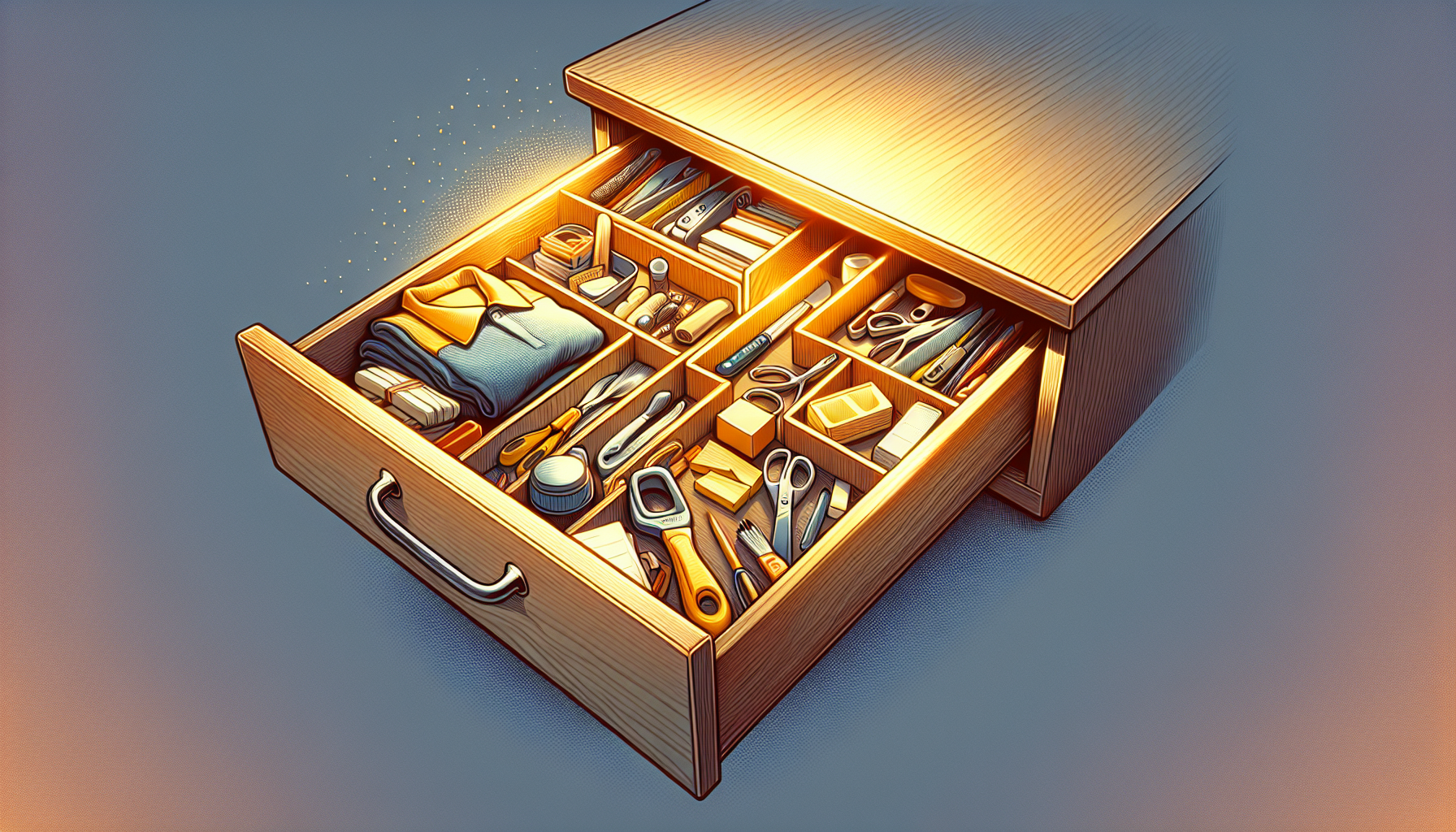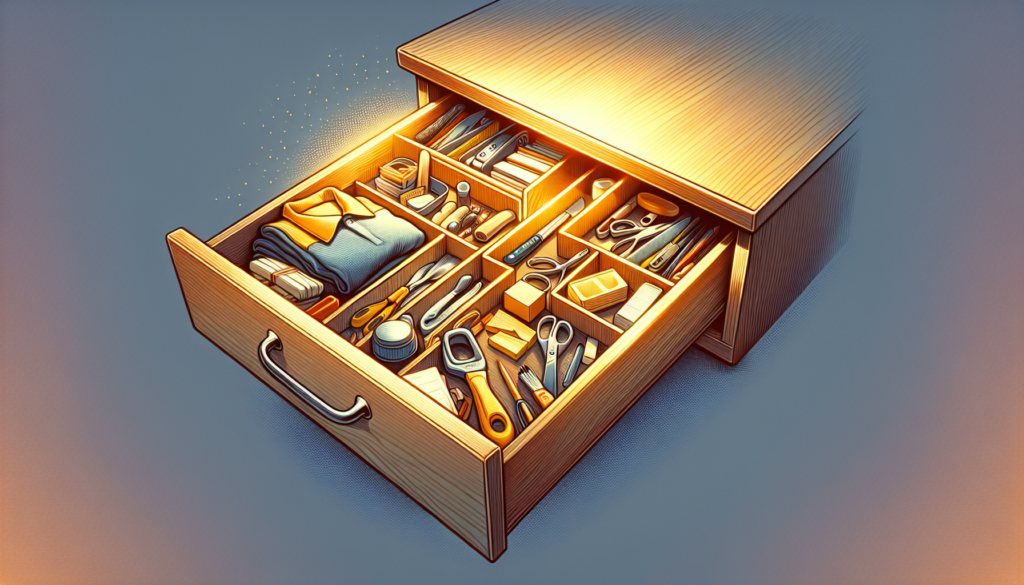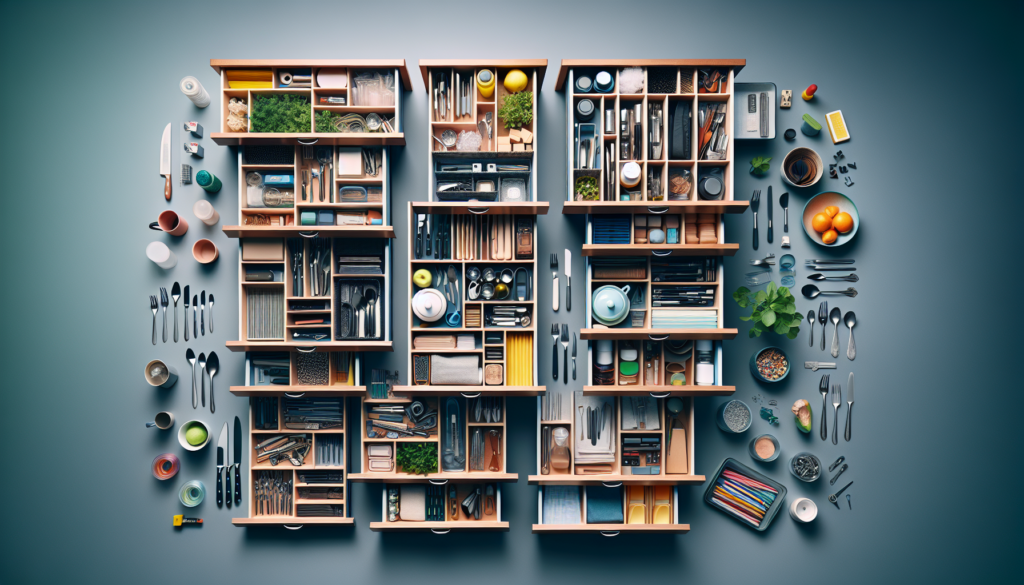
Are your drawers in chaos? It’s time to bring some order into your life! In this article, we will share with you some expert-approved techniques for organizing your drawers. From the kitchen to the bedroom, we have got you covered. Say goodbye to rummaging through piles of clothes or searching endlessly for that missing utensil. With these simple but effective tips, you’ll have beautifully organized drawers in no time. So, grab your organizing supplies and get ready to transform your space into a haven of tidiness and efficiency.

1. Decluttering Your Drawers
1.1 Assessing the Contents
Before you start organizing your drawers, it’s essential to assess the contents of each drawer. Take everything out and lay it out on a clean surface. This will give you a clear picture of what you have and help you identify any unnecessary or unused items. As you go through each item, ask yourself if it serves a purpose or brings you joy. If the answer is no, it’s time to let go.
1.2 Sorting and Categorizing
Once you’ve assessed the contents of your drawers, it’s time to sort and categorize them. Group similar items together so that you can easily find what you need when you’re looking for it. For example, separate your socks from your underwear and your t-shirts from your jeans. This process will make it easier to keep track of your belongings and maintain an organized system.
1.3 Letting Go of Unnecessary Items
One of the most important steps in decluttering your drawers is letting go of unnecessary items. It can be difficult to part with things, but it’s crucial to only keep what you truly need and use. If you come across items that no longer serve a purpose in your life, consider donating or selling them. By letting go of the things you no longer need, you’ll create more space in your drawers and make room for the items that truly matter.
2. Utilizing Drawer Dividers
2.1 Understanding the Purpose of Drawer Dividers
Drawer dividers are a game-changer when it comes to organizing your drawers. They help separate and categorize different items, making it easier to locate what you need without creating a mess. With dividers, you can maximize the space in your drawers and prevent items from getting jumbled together. They are especially useful for smaller items like accessories, utensils, and stationery.
2.2 Choosing the Right Dividers for Your Drawers
When choosing the right dividers for your drawers, consider the size and shape of the items you plan to store. There are various types of dividers available, including adjustable dividers, expandable dividers, and custom dividers. Adjustable dividers allow you to create different-sized compartments, while expandable dividers can be adjusted to fit your drawer’s dimensions. Custom dividers are ideal if you have specific requirements or irregularly shaped items.
2.3 Arranging and Adjusting Dividers
Once you have selected the appropriate dividers for your drawers, it’s time to arrange and adjust them to suit your needs. Start by placing dividers in a way that creates separate sections for your different categories of items. You can adjust the dividers as needed to fit your items snugly, preventing them from shifting around when you open and close the drawer. Experiment with different configurations until you find the most efficient layout that works for you.
3. Implementing Folding Techniques
3.1 KonMari Folding Method
The KonMari folding method, popularized by Marie Kondo, is a technique that maximizes space and keeps your clothes neatly organized. Start by folding your clothes into small rectangles, then file them vertically in your drawers. This method allows you to see all your clothes at once, making it easier to select what you want to wear without disturbing the rest. It also prevents clothes from becoming wrinkled or forgotten at the bottom of the pile.
3.2 Traditional Folding Techniques
If you prefer a more traditional approach to folding, there are several tried-and-true methods you can employ. For example, you can fold t-shirts in half vertically and then in half horizontally or fold them into thirds and stack them on top of each other. For bulkier items like sweaters, consider folding them in thirds and then rolling them to maximize space. Experiment with different folding techniques to find the one that suits you and your items best.
3.3 Utilizing Specialized Folding Tools
If you want to take your folding game to the next level, consider investing in specialized folding tools. These tools, such as folding boards or templates, can help you achieve consistently neat folds and save time. They are especially useful for items like shirts, pants, and linens. Keep in mind that while these tools can be helpful, they are not essential. With a little practice, you can achieve tidy folds without them.

4. Organizing Drawers by Corresponding Categories
4.1 Grouping Similar Items Together
When organizing your drawers, it’s important to group similar items together. This will make it easier for you to find what you need quickly and efficiently. For example, if you have a drawer for kitchen utensils, group all the spoons together, all the forks together, and so on. By clustering related items, you create a logical system that makes sense to you and anyone else who may need to access your drawers.
4.2 Designating Sections for Different Categories
To further enhance your drawer organization, consider designating sections for different categories of items. For example, within your kitchen utensil drawer, you can have a section for cooking utensils, a section for baking tools, and a section for serving utensils. This division of space allows you to keep similar items together and prevents them from getting mixed up or lost. Use dividers or containers to create these distinct sections within your drawers.
4.3 Arranging Items in Priority Order
To optimize your drawer organization, arrange your items in order of priority. Place the items you use most frequently in the most accessible parts of the drawer, while less frequently used items can be stored towards the back. This ensures that the things you reach for often are within easy reach and saves you time and effort when you’re searching for something specific. Reevaluate your drawer arrangement periodically to make adjustments based on your changing needs and usage patterns.
5. Utilizing Clear Storage Containers
5.1 Advantages of Clear Storage Containers
Using clear storage containers in your drawers offers several advantages. First, they allow you to see the contents of each container at a glance, eliminating the need to rummage through a cluttered drawer. Second, clear containers provide added protection for your items by keeping them contained and preventing them from getting damaged or misplaced. Finally, they add a sense of uniformity and visual appeal to your drawer organization, creating a cohesive and put-together look.
5.2 Selecting the Right Size and Shape
When choosing clear storage containers for your drawers, consider the size and shape of the items you plan to store. Measure your drawer dimensions and take note of any height or width restrictions. Opt for containers that fit snugly in your drawers without wasting any space. Additionally, consider stackable containers if you have limited drawer space, as they allow you to make the most of the vertical space available.
5.3 Labeling Containers for Easy Identification
To ensure easy identification of items in your clear storage containers, consider labeling them. Labeling can be as simple as using small adhesive labels or sticky notes on the front of each container, or you can invest in a label maker for a more professional look. Clearly indicate the contents of each container, making it easy to locate specific items without having to open every container. Labeling adds an extra layer of organization and saves you time and effort in the long run.
6. Maximizing Vertical Space
6.1 Utilizing Drawer Dividers Vertically
Not only are drawer dividers useful for separating items horizontally, but they can also help maximize vertical space. Consider using dividers vertically to create separate compartments within compartments. This technique is especially handy for storing smaller items like socks, lingerie, and accessories. By utilizing the entire height of your drawer, you can keep your belongings organized and accessible while making the most of limited space.
6.2 Using Drawer Organizers with Multiple Stacks
Another way to maximize vertical space in your drawers is by using drawer organizers with multiple stacks. These organizers feature tiers or levels that allow you to stack items on top of each other without creating a chaotic mess. This is particularly useful for items with varying sizes, such as folded clothes or office supplies. By utilizing multiple stacks, you create efficient storage solutions that optimize every inch of your drawer.
6.3 Installing Hooks or Hanging Systems
If your drawer space is limited, consider utilizing hooks or hanging systems inside your drawers to maximize vertical space. This technique works well for items like belts, ties, and jewelry. Install hooks or small rods at the back or sides of your drawers to hang these items and keep them organized and easily accessible. By utilizing hanging systems, you can create additional storage options without sacrificing valuable drawer space.
7. Organizing Drawers with Drawer Liners
7.1 Advantages of Using Drawer Liners
Using drawer liners is an excellent way to protect your drawers and keep them clean and fresh. Drawer liners provide a barrier between your belongings and the drawer’s surface, preventing any dirt, dust, or spills from directly contacting the wood or plastic. They also add a touch of sophistication to your drawers and can help prevent items from shifting or sliding around when you open and close the drawer.
7.2 Choosing Appropriate Liner Materials
When selecting drawer liners, it’s essential to choose appropriate materials that suit your needs. Non-adhesive liners are suitable for most drawers, as they can be easily removed and cleaned. Opt for liners made from materials like vinyl or fabric that are durable and water-resistant. If you want added protection against spills or excessive moisture, consider adhesive liners or liners with rubber backing. Choose materials that are easy to clean and maintain, ensuring your drawers remain in optimal condition.
7.3 Installing and Replacing Drawer Liners
Installing drawer liners is a straightforward process. Start by measuring your drawers to determine the amount of liner you need. Cut the liner to size and place it at the bottom of the drawer. Smooth out any wrinkles or air bubbles to ensure the liner lies flat. If necessary, use adhesive or double-sided tape to secure the liner in place. Remember to periodically inspect and replace your drawer liners to keep them fresh and maintain a clean and organized drawer space.
8. Streamlining with Drawer Labels
8.1 Importance of Drawer Labels
Drawer labels are a simple yet effective way to streamline your organization system. Labels provide clear guidance on the contents of each drawer, making it easy to locate items and maintain order. They also help others in your household navigate your drawers with ease. Additionally, labels can serve as a visual reminder to put items back in their designated place, helping to maintain organization in the long run.
8.2 Different Styles and Types of Labels
When creating drawer labels, you have a range of styles and types to choose from. Handwritten labels using adhesive labels or sticky notes are a cost-effective and straightforward option. If you prefer a cleaner, more professional look, consider using a label maker. Label makers offer various font options and styles to suit your preferences. Alternatively, you can get creative and use printable labels or even write directly onto the drawer surface with a washable marker.
8.3 Labeling Techniques for Various Drawer Types
Different drawer types may require specific labeling techniques. For drawers with flat surfaces, adhesive labels or sticky notes can be easily applied directly onto the drawer front. If your drawers have recessed handles or knobs, consider labeling the inside of the drawer front or using removable labels that can be attached to the handle. Be mindful of the aesthetics and functionality of your labels, ensuring they are legible and don’t obstruct the drawer’s functionality.
9. Maintaining and Refreshing Organization
9.1 Regularly Assessing and Decluttering
Maintaining an organized drawer system requires regular assessments and decluttering sessions. Set aside time every few months to go through your drawers and assess if any items need to be purged or rearranged. As you continue to use your drawers, you may find that certain items are no longer needed or that you need to adjust your organization system to better accommodate your changing needs. By regularly assessing and decluttering, you ensure your drawers remain functional and clutter-free.
9.2 Reevaluating and Adjusting Drawer Systems
Drawer systems are not set in stone. As your storage needs change, it’s important to reevaluate and adjust your drawer systems accordingly. Take note of any inefficiencies or areas that could be improved upon. Consider feedback from family members or roommates who use the same drawers to ensure everyone’s needs are met. Have a flexible mindset and be willing to make changes as necessary to maintain an organized and functional drawer space.
9.3 Establishing Ongoing Maintenance Routine
To keep your drawers organized in the long term, it’s crucial to establish an ongoing maintenance routine. This routine may include periodic decluttering, reevaluating, and adjusting your drawer systems, as well as regular cleaning and upkeep of your drawer liners. Set aside dedicated time in your schedule to maintain your organized drawers, and make it a habit to put items back in their designated places after use. By incorporating these practices into your routine, you’ll enjoy an organized and clutter-free drawer space for years to come.
10. Creative and Customized Drawer Solutions
10.1 Custom Drawer Inserts
If you have unique organizational needs or items that don’t fit standard drawer dividers or organizers, consider custom drawer inserts. Custom inserts can be tailored to fit the exact dimensions of your drawers and meet your specific requirements. Whether you need compartments for jewelry, art supplies, or electronics, a custom insert can provide the perfect solution. Work with a professional organizer or explore DIY options to create inserts that maximize your drawer space and keep your belongings in order.
10.2 DIY Drawer Organization Ideas
For those who enjoy getting creative and hands-on, there are plenty of DIY drawer organization ideas to explore. Repurpose items you already have, such as small boxes, cutlery trays, or ice cube trays, to create customized compartments for your drawers. Use fabric or wallpaper scraps to line your drawers and add a personal touch. Explore online tutorials and inspiration to find unique and budget-friendly ways to organize your drawers with a DIY approach.
10.3 Professional Customization Options
If you prefer a professional touch, various companies offer customization options for your drawers. Professional organizers or closet design companies can assess your needs and create tailored drawer solutions that maximize your space and meet your specific requirements. From custom-sized dividers to built-in drawer organizers, these professionals can help transform your drawers into functional and aesthetically pleasing storage spaces. Consider hiring a professional if you want a polished and customized look for your drawers.
In conclusion, organizing your drawers is an essential step in creating an orderly and functional living space. By decluttering, utilizing dividers, employing effective folding methods, and implementing various organization techniques, you can transform your drawers into efficient storage spaces. Remember to regularly assess, reevaluate, and maintain your organized drawers to ensure long-term success. With a little effort and creativity, you can achieve expert-approved drawer organization that makes your everyday life simpler and more enjoyable.